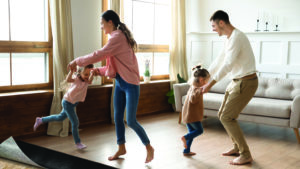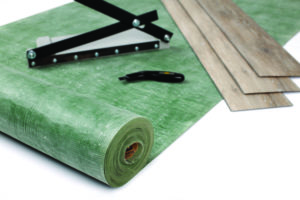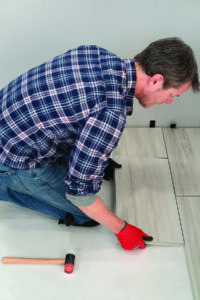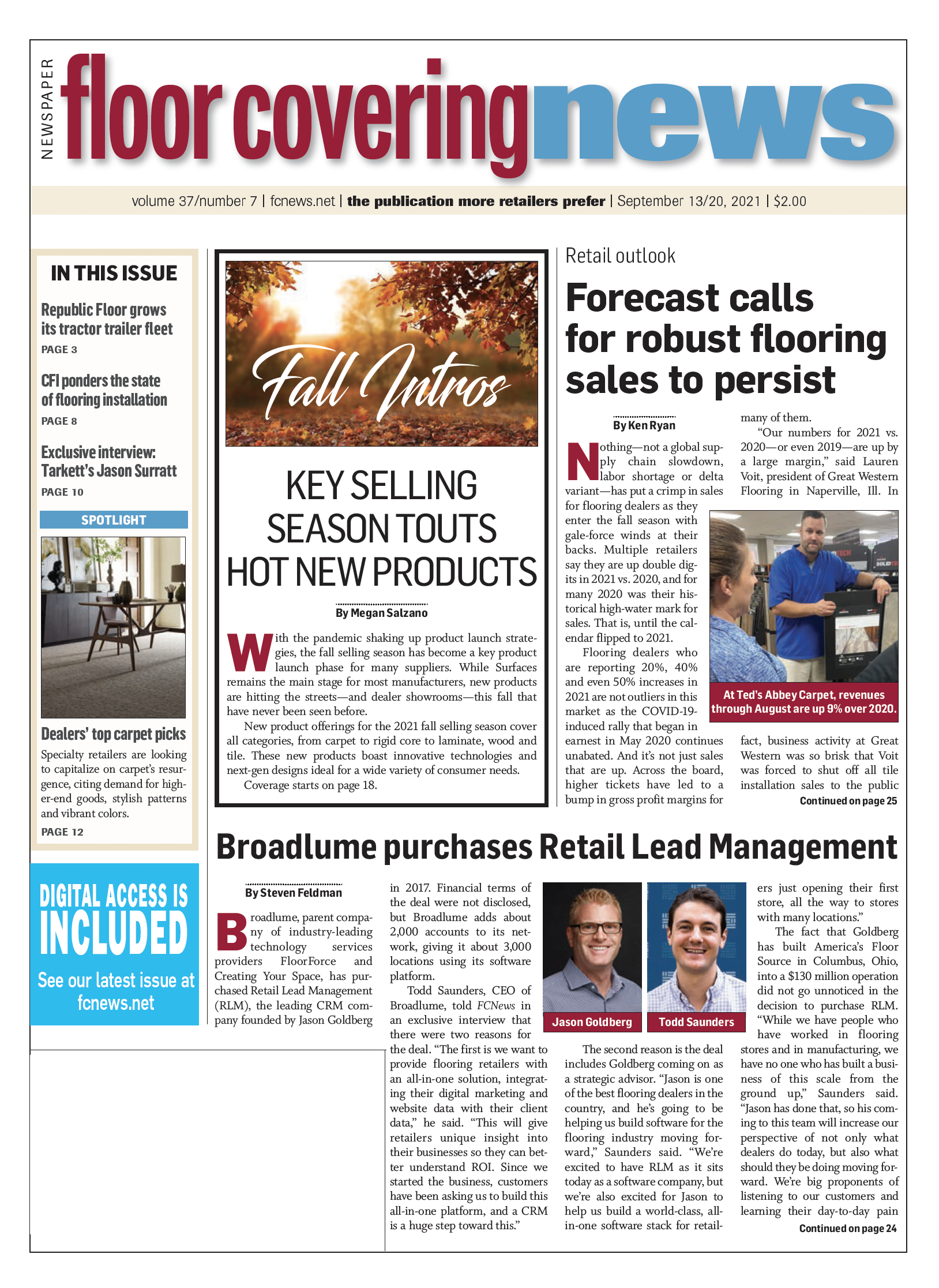
By K.J. Quinn—A common theme for innovation in most industries is “better, faster, cheaper,” and flooring installation is no different. An ongoing debate is how products with a pre-attached padding stack up in the long term against conventional underlayment installed separately.
“Unfortunately, there’s not really a specific industry organization that sets standards for the vinyl planks, tiles and accessories,” said Deanna Summers, marketing specialist and account manager at MP Global Products, a flooring underlayment supplier. “Therefore, we perform our own R&D to make products that enhance the installations of vinyl flooring.”
The meteoric growth of hard surface flooring—rigid core and WPC in particular—has been triggered largely by innovations in performance and visuals. In recent years, many vendors have attached underlayment to the boards as a matter of convenience. The thought process being: customers would not have to roll out a separate layer on the subfloor prior to installation if backing was already included on the planks. However, some experts say that one underlayment should not preclude the need for another layer.
“Attached padding could provide moisture mitigation attributes and allow installers to consider bypassing otherwise required steps of subfloor preparation,” noted David Jackson, DriTac Flooring Products’ director of field technical services. “Overall, the installation could be made less expensive and less time consuming with an attached backing option.”
A major selling point of pre-attached padding, proponents say, is it speeds up installation, saving time and money for end users. “Oftentimes, these attached underlayments are very lightweight styrene or some variation, which easily attaches and provides a great story to market,” said Chris Palmer, vice president of sales, Leggett & Platt, a flooring underlayment provider. “However, the drawback is the actual underlayment is so lightweight that it might not provide long-lasting support.”
Pros vs. cons

Like any product, there are pluses and minuses associated with pre-attached padding. The decision to use one or the other (or both) largely depends on the requirements of the customer or the specific demands of the job site. “The choice for the consumer will predominantly hinge on the specific attributes of the product,” DriTac’s Jackson explained. “Moisture and sound control properties will differ from product to product, necessitating the decision to be made on a project-by-project basis.”
Cost and convenience are among the factors for determining whether a moisture barrier attached to the underlayment is preferred instead of buying it separately.
One concern with some pre-attached underlayments is they can leave insulation gaps between boards. “A consumer may also get the impression that the attached underlayment may prevent moisture migration when, in fact, the cushion is cut to the very same dimensions of the floor, thus negating that benefit,” Leggett & Platt’s Palmer pointed out. “Noise vibration tends to also find seams and is a conduit for channeling noise, which can also be a problem.”
Moisture protection is a major issue, experts say, especially in a world where many hard surface floors are marketed as being waterproof. The general rule of thumb is job sites that experience a moisture problem or have a concrete subfloor require a moisture barrier. “The exposed seams of the pad-attached planks do leave some vulnerabilities to the floor over time when it comes to moisture,” MP Global’s Summers stated. “Having full subfloor coverage of an underlayment will help against vapors being trapped and causing issues like mold growth and alkalinity migration through the cracks of the planks to the flooring surface.”
Indeed, certain qualities of premium-grade underlayments surpass the capabilities of attached padding. “When attempting to achieve a particular sound rating, attached padding is unlikely to provide the best solution when compared to a separate layer of underlayment,” DriTac’s Jackson said. “Some hard surface coverings might feel more firm or uncomfortable underfoot with a thin layer of attached padding than with the added cushion of an underlayment.”
All of which begs the question: which option is better? While both attached pad and separate underlayment can be effective, the tie breakers are often costs or which solution provides the desired results.
The upfront cost savings for consumers purchasing floors with pre-attached padding is a major selling point. However, most floors with attached backings feature a locking system that can be damaged if the product is installed over an uneven substrate. “A rough surface such as pebbles in concrete, fastener heads or uneven joints in OSB or wood subfloors may need a thicker, more substantial underlayment to help smooth out those imperfections,” MP Global’s Summers explained.
Some projects mandate increasing the overall height of the floor—a situation where a separate underlayment might be the most cost-effective solution. “While the pad attached to your hard surface flooring might closely resemble a separate foam or rubber underlayment, the engineering of premium-grade, multifunctional underlayments have evolved far past attached pads,” DriTac’s Jackson reported.
A pad for every need

Underlayments are made from various materials—such as foam, foam mixed with rubber, felt and cork—and price points and benefits vary. For instance, Ecore’s itsTRU technology enables it to fusion-bond virtually any flooring surface to its vulcanized composition rubber (VCR) backing. “itsTRU technology allows Ecore to combine the inherit performance of VCR with an endless array of surface layers, including VCR, turf, vinyl and carpet,” said Bo Barber, executive vice president of sales and marketing. “Ecore products featuring itsTRU technology have enhanced safety, ergonomic and acoustic attributes.”
Leggett & Platt’s Palmer added, “The constant testing done on Whisper Step continues to find benefits for sound, support and moisture protection.”
Dal-Tile offers a porcelain tile product that offers the best of both worlds. RevoTile features a “backer” attached to the tile and an innovative click installation system that allows the product to install 50% faster than some traditional tile floors. “RevoTile installs right over many existing floors, avoiding the need for demolition and removal,” Patrick Warren, vice president of residential sales, dealer and showrooms, stated. “There is no mortar drying time, no two-part grout and no return visits.”
A separate, unattached moisture barrier underlayment, called RapidPrep, features a shock-absorbing structure that is designed to maximize the performance of RevoTile’s locking system. “RapidPrep underlayment also improves underfoot comfort, provides compression strength as well as thermal insulation, is compatible with many types of underfloor heating and reduces sound transmission,” Warren said.
Suppliers say dealers can gain a much better understanding of their customers’ projects during the qualification process, which enables them to advise on which underlayment option works best. “We recommend following the manufacturer’s installation and maintenance guidelines to maximize the longevity of your flooring,” Ecore’s Barber explained.
For example, one major consideration for multifamily housing applications is a strict local code or covenant requiring a minimum acoustic score for Impact Insulation Class (IIC) or Sound Transmission Class (STC). “Some required score numbers may be difficult to achieve without adding an additional underlayment to the installation assembly,” MP Global’s Summers noted.
For many consumers, the decision boils down to which underlayment best supports their flooring choice. “The best course is to determine which product offers the greatest level of security in the long term,” DriTac’s Jackson said. “However, as multifunctional underlayments continue to evolve, the moisture mitigation, sound abatement and cushion qualities of attached padding could struggle to meet the same standard.”

